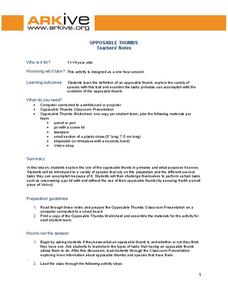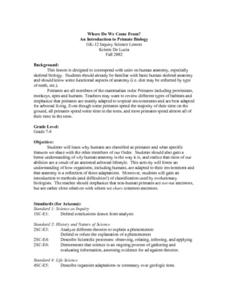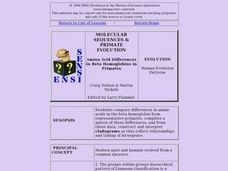Howard Hughes Medical Institute
Human Feet Are Strange
Feet are neat! So, if you've already walked the path of examining animal footprints with your class, put them in the shoes of early humans! A well-designed lesson incorporates video, discussion, and hands-on learning to demonstrate how...
California Academy of Science
Color Vision Genetics Evolution Simulation
At one point, all mammals carried only two color receptors, but now most humans carry three. An informative presentation and hands-on activity demonstrate how this evolved through genetics. By participating in the activity, pupils...
Biology Junction
Mammals
Mammals include more than 4,000 species and represent the most dominant land animals on Earth. Scholars learn about the large variety of mammals, including orders unfamiliar to most. The presentation highlights the characteristics and...
ARKive
Opposable Thumbs
How do opposable thumbs help you complete certain tasks? An activity about evolutionary traits prompts learners to try writing their name, twist the lid off of a jar, and use tweezers to pick up a straw, first with their normal grip, and...
Curated OER
Protect the Primates
Students make posters about saving the primates. In this primates lesson plan, students discuss primates and environmental changes and make posters with pictures about saving primates.
Curated OER
Primate Evolution
A short slide show lists the unique adaptations of primates, introduces early primates, and examines hominid evolution. Consider adding some drawings or graphics to enliven the presentation.
Curated OER
From Restriction Maps to Cladograms
Biology aces analyze restriction maps to determine the relationships among different primate species and then complete a cladogram. Preface this instructional activity with an explanation of how restriction enzymes are used to create the...
Curated OER
Where Do We Come From? An Introduction to Primate Biology
Seventh graders explore skeletal biology. Through a discussion and video observation, 7th graders investigate how the anatomy is adapted to the environment. Students study primates and explore their characteristics and behaviors.
Curated OER
Primates
Young scholars explore different primates. In this primate lesson, students examine the various primates by engaging in crafts, dramatic play, singing songs, and games.
Curated OER
Classification of Intertidal Organisma
Students categorize animals. For this animal classification lesson, students group animals by their characteristics. Students break into groups and work together to classify the animals. Students fill out a graphic organizer with their...
Curated OER
The Great Apes
Students prepare experiment plans for a peer review session to test the intelligence level of gorillas. They view and discuss a Discovery Channel video on the wild behaviors of gorillas then create three experiments that could test the...
Curated OER
Molecular Sequences & Primate Evolution: Amino Acids, Hemoglobins in Evolution
Students compare differences in amino acids in the beta hemoglobin from representative primates, complete a matrix of those differences, and from these data, construct and interpret cladograms as they reflect relationships and timing of...
Curated OER
Apes To Man
Students study primates and their evolution history. In this role play lesson students view a video on evolution then demonstrate how primates walked and other observations they noticed in the film.
Curated OER
What's A Mammal?
Students examine mammals understanding what a mammal is and reviewing the eleven mammal groups. In this science lesson, students play a game known as Mystery Mammal Game. Yet, first students research about the mammal and then give...
Curated OER
Ape Genius
Students watch a video and discuss the research on the intelligence of apes. In this primate lesson, students view a NOVA video about ape intelligence. They work in groups to take notes on the observations and conclusions of researchers...
Curated OER
Which Mammal Group?
In this mammals worksheet, students match 6 animal pictures to one of the six common mammal groups such as marsupials, rodents, and primates.
Curated OER
Primate Evolution
In this evolution activity, students review 9 terms associated with the evolution of primates. Students place 6 terms into a crossword puzzle and 3 terms into fill in the blank statements.
Curated OER
Primate Classification 2006
Students examine groups of hierarchy and see how primates are categorized. In this primate classification lesson students view video and slides then examine the taxonomy of primates.
Curated OER
The Opposable Thumb
Students explore the physical importance of the opposable thumb among primates. They discover which of their simplest daily activities are possible only because of their opposable thumbs.
University of Wisconsin
University of Wisconsin: Capuchin Monkey (Cebus)
Comprehensive exploration on the taxonomy of the Capuchin Monkey that includes links to detailed factsheets on the varied species with an extensive glossary of terms.
University of Wisconsin
University of Wisconsin: Howler Monkey
Comprehensive discussion on the taxonomy of the Howler Monkey with detailed factsheets on the varied species that include an extensive glossary of terms.
University of Wisconsin
University of Wisconsin: Red Howler (Alouatta Seniculus)
Comprehensive discussion on the taxonomy, morphology, range, habitat, and ecology of the Red Howler Monkey in this detailed factsheet that includes an extensive glossary of terms.
University of Wisconsin
University of Wisconsin: Squirrel Monkey
Comprehensive discussion on the taxonomy, morphology, range, habitat, and ecology of the Squirrel Monkey in this detailed factsheet that includes an extensive glossary of terms.
University of Wisconsin
University of Wisconsin: Woolly Monkey
Comprehensive discussion on the taxonomy, morphology, range, habitat, and ecology of the Woolly Monkey in this detailed factsheet that includes an extensive glossary of terms.
























